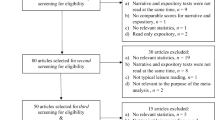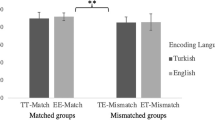Abstract
It is fairly clear that story-relevant pictures help children recall story information. But do pictures showing details distract students’ attention from central information, and thus hinder recall? In this study of second and fifth graders, such pictures (as well as subject-generated images) facilitated recall of both central and incidental information contained in single-sentence mini-stories.
Similar content being viewed by others
References
Brown, A. L., & Smiley, S. S. The development of strategies for studying texts.Child Development, 1978,49, 1076–1088.
Dunham, T. C., & Levin, J. R. Imagery instructions and young children’s prose learning: No evidence of “support.”Contemporary Educational Psychology, in press.
Gomulicki, B. R. Recall as an abstractive process.Acta Psychologica, 1956,22, 77–94.
Guttmann, J., Levin, J. R., & Pressley, M. Pictures, partial pictures, and young children’s oral prose learning.Journal of Educational Psychology, 1977,69, 473–480.
Kirk, R. E.Experimental design: Procedures for the behavioral sciences. Belmont, Calif.: Brooks/Cole, 1968.
Levin, J. R. What have we learned about maximizing what children learn? In J. R. Levin & V. L. Allen (Eds.),Cognitive learning in children: Theories and strategies. New York: Academic Press, 1976.
Levin, J. R., & Lesgold, A. M. On pictures in prose.Educational Communication & Technology Journal, 1978,16, 233–243.
Peeck, J. Retention of pictorial and verbal content of a text with illustrations.Journal of Educational Psychology, 1974,66, 880–888.
Poulsen, D., Kintsch, E., Kintsch, W., & Premack, D. Children’s comprehension and memory for stories.Journal of Experimental Child Psychology, in press.
Pressley, G. M. Mental imagery helps eightyear-olds remember what they read.Journal of Educational Psychology, 1976,68, 355–359.
Pressley, M. Imagery and children’s learning: Putting the picture in developmental perspective.Review of Educational Research, 1977,47, 585–622.
Reese, H. W. Imagery and contextual meaning. In H. W. Reese (Chm.), Imagery in children’s learning: A symposium.Psychological Bulletin, 1970,73, 404–414.
Ruch, M. D., & Levin, J. R. Partial pictures as imagery-retrieval cues in young children’s prose recall.Journal of Experimental Child Psychology, in press.
Samuels, S. J. Effects of pictures on learning to read, comprehension and attitudes.Review of Educational Research, 1970,40, 397–407.
Schallert, D. L. The role of illustrations in reading comprehension. In R. J. Spiro, B. C. Bruce, & W. F. Brewer (Eds.),Theoretical issues in reading comprehension. Hillsdale, N.J.: Erlbaum, in press.
Shimron, J. Imagery and the comprehension of prose by elementary school children (Doctoral dissertation, University of Pittsburgh, 1974).Dissertation Abstracts International, 1975,36, 795A. (University Microfilms No. 75-18, 254)
Willows, D. M. A picture is not always worth a thousand words: Pictures as distractors in reading.Journal of Educational Psychology, 1978,70, 255–262.
Author information
Authors and Affiliations
Additional information
This research was funded by the Wisconsin Research and Development Center for Individualized Schooling, supported in part as a research and development center by funds from the National Institute of Education (Center Contract OB-NIE-G-78-0217). The opinions expressed herein do not necessarily reflect the positions or policy of the NIE, and no official endorsement by the NIE should be inferred. The authors are grateful to the staff and students of Hoyt, Midvale, and Thoreau Schools in Madison, Wisconsin, for enabling us to conduct the study, and to Trudy Dunham for helping develop the materials.
Rights and permissions
About this article
Cite this article
Levin, J.R., Bender, B.G. & Pressley, M. Pictures, imagery, and children’s recall of central versus peripheral sentence information. ECTJ 27, 89–95 (1979). https://doi.org/10.1007/BF02765330
Issue Date:
DOI: https://doi.org/10.1007/BF02765330




